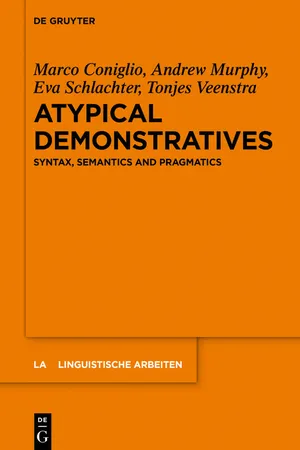There is a long-standing debate regarding the category of demonstratives. A well established tradition claims that they belong to the functional category “determiner”, which includes articles, quantifiers, personal pronouns and, in some languages, possessive adjectives and pronouns. This view is based on the fact that demonstratives are often found in complementary distribution with these elements. At the opposite side, another well-established tradition claims that they belong to the lexical category “adjective”, especially in languages with no articles. This view is based on the fact that demonstratives often display adjectival morphology and the same behavior of adjectives as regards word order and extractability. A third, novel view put forth by Diessel (2006) considers demonstratives as neither functional (or D-like in our terms) nor lexical (or A-like in our terms) but as “categories of the third kind”, more primitive than any other linguistic category, directly pointing in space and serving the communicative function of establishing joint attention. In this contribution, I provide a syntactic account of demonstratives in the framework of phase theory (Chomsky 2008 and much work following him), which can conciliate these three apparently alternative views.
1.1The syntax of demonstratives in previous literature
When it comes to the structural position of demonstratives, the two more traditional approaches (functional-determiner status vs. lexical-adjectival status) divide in a number of different possibilities.
In the demonstrative-as-determiner approach (Abney 1987, Longobardi 1994, a.o.), it is generally assumed that demonstratives are in D, as in (1a), heading the highest functional projection of the nominal expression (henceforth NE, a term that allows us to remain agnostic as to the actual label of the complete nominal projection). But it has also been proposed that demonstratives are in other positions, on evidence from languages where demonstratives can or must cooccur with articles. In particular, it has been claimed that demonstratives are specifiers (Giusti 1997, 2002, Brugè 1996, 2002), and this opens up the possibility for them to be merged in SpecDP, as in (1b), or in lower specifiers, as will be shown later in the paper:
In this perspective, the demonstrative-as-determiner-approach becomes compatible with the demonstrative-as-adjective approach, especially in view of the well known fact that adjectives come in different classes, undergoing a rigid hierarchy. The similarities with adjectives can be attributed to adjectival status, while the differences between demonstratives and other adjectives can be attributed to a difference among adjectival classes.
The structural position of adnominal adjectives is, in general, also subject to debate. Alternative analyses take adjectives as specifiers of NP, as in (1) above, or as heads selecting an NP, as in (2a) (cf. Bouchard 1998, 2002), or as maximal projections adjoined to NP, as in (2b) (cf. Bošković 2005), or as predicates of a reduced relative clause, as in (3), (cf. Alexiadou & Wilder 1998 and den Dikken 1998, who follow Kayne 1994):
As reported by Corver & van Koppen (this volume), according to den Dikken (1998), (3a) is the structure of indirect modification, where the AP is the predicate and the NP moves to SpecFP; while (3b) derives (direct modification) adpositional adjectives from the indirect modification structure, leaving NP in SpecXP and raising the AP predicate to SpecFP:2
| (3) | a. | [DP the [FP [NP mother]j F [XP [NP mother] ... [AP proud of her son] |
| b. | [DP the [FP [AP yellow] F [XP [NP book] ... [AP yellow]]]] |
In this line of analysis, Corver (2003, 2008) claims that in Dutch, the possessive pronoun is embedded in a possessive PP predicated of the NP boek which is in SpecXP, the specifier of the predicate phrase, whose head X is filled by the morpheme ’n, as in (4a). The derivation proceeds as in (4b): P incorporates to X, obtaining X+P, which further incorporates to F. Then the whole PP predicate moves to SpecFP. Finally ’n encliticizes onto mij to obtain mijn:
| (4) | a. | [DP D [FP Spec F [XP [NP boek] [X’ ’n [PP PDAT mij ]]]]] ⇒ |
| b. | [DP D [FP [PP tk mij]i F+[X (=’n)+Pk]j [XP [NP boek] [X’ tj ti ]]]] |
Corver & van Koppen (this volume) apply (4) to demonstratives. Since the demonstrative cannot be a predicate, they propose that it is the “subject” of the DP-internal predication, following Campbell’s (1996) predication approach to NEs, according to which, when the demonstrative is merged, NP is the predicate of the DP-internal predication. The result is a structure like (5a) which is the base of (5b) with DEM moving from SpecXP to SpecDP:
| (5) | a. | [DP D [XP DEM [X’ X [NP PREDICATE ]]]] |
| b. | [DP DEM D [XP DEM [X’ X [NP PREDICATE ]]]] |
With this overabundance of alternatives at the background, cross-linguistic variation in the syntax of demonstratives raises the question as to whether their categorial nature and/ or different merging positions is subject to parametric variation.



